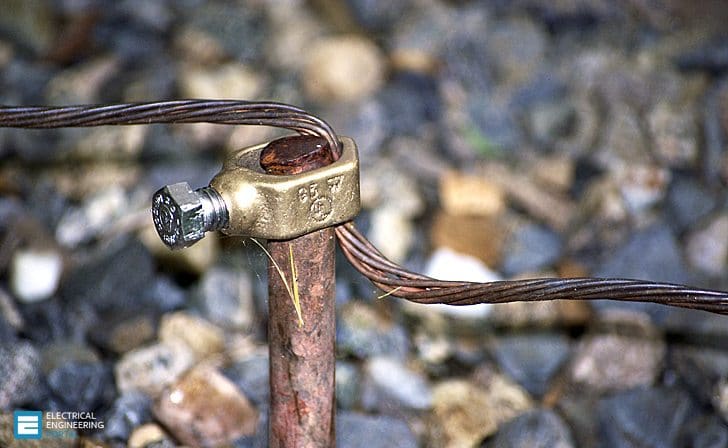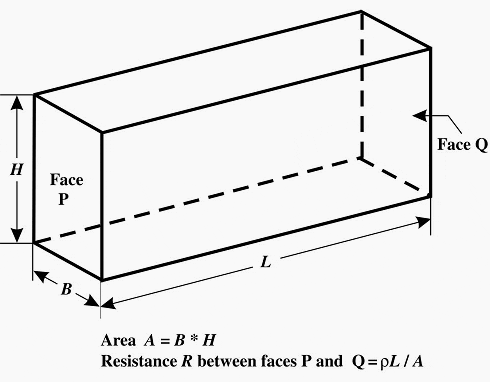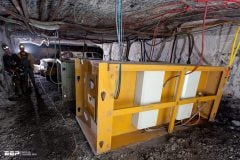Soil resistivity definition //
Though the ground itself being a very large body can act as an infinite sink for currents flowing into it and can be considered to be having very low resistance to current flow, the resistance of soil layers immediately adjacent to the electrode can be considerable.

Soil has a definite resistance determined by its resistivity that varies depending upon the type of soil, presence of moisture and conductive salts in the soil and the soil temperature.
Resistance of the sample of soil shown in Figure 1 can be arrived at by the formula:
R = ρ · L / A
Where:
- R -is the resistance between faces P and Q Ohm
- A -Area pr faces P and Q (mz)
- L -Length of soil sample in meter
- ρ -Soil reisistivity Ohm-m


Soil resistivity for a given type of soil may vary widely depending on:
- The presence of conducting salts
- Moisture content
- Temperature
- Level of compaction.
Conducting salts may be present naturally in the soil or added externally for lowering the resistivity. Chlorides, nitrates and sulfates of sodium, potassium, magnesium or calcium are generally used as soil additives.
However, the addition of such salts can be corrosive and in some cases undesirable from the environmental point of view. Especially, the presence of calcium sulfate in the soil is detrimental to concrete foundations and in case it is to be used for electrode quality enhancements, it should be limited to electrodes situated well away from such foundations. Also, over a period, they tend to leach away from the vicinity of the electrode.
Moreover, these additive salts have to first get dissolved in the moisture present in the soil in order to lower the resistivity, and provision should be made for addition of water to the soil surrounding the electrode to accelerate this process particularly in dry locations.
Moisture of soil //
Moisture is an essential requirement for good soil conductivity. Moisture content of the soil can vary with the season and it is advisable for this reason to locate the electrodes at a depth at which moisture will be present throughout the year so that soil resistivity does not vary too much during the annual weather cycle.
It is also possible that moisture evaporates during ground faults of high magnitude for long duration. The electrode design must take care of this aspect.
Effect of moisture content on soil resistivity //
| Moisture Content (%) | Resistivity (in ohmmeter) | ||
| Top Soil | Sandy Loam | Red Clay | |
| 2 | *** | 1850 | *** |
| 4 | *** | 600 | *** |
| 6 | 1350 | 380 | *** |
| 8 | 900 | 280 | *** |
| 10 | 600 | 220 | *** |
| 12 | 360 | 170 | 1800 |
| 14 | 250 | 140 | 550 |
| 16 | 200 | 120 | 200 |
| 18 | 150 | 100 | 140 |
| 20 | 120 | 90 | 100 |
| 22 | 100 | 80 | 90 |
| 24 | 100 | 70 | 80 |
Temperature of soil //
Temperature also has an effect on soil resistivity but its effect is predominant at or near 0ºC when the resistivity sharply goes up. Similarly, compaction condition of the soil affects resistivity. Loose soil is more resistive in comparison to compacted soil.
Effect of temperature on soil resistivity
| Temperature (°C) | Resistivity (in ohmmeter) |
| -5 | 700 |
| 0 | 300 |
| 0 | 100 |
| 10 | 80 |
| 20 | 70 |
| 30 | 60 |
| 40 | 50 |
| 50 | 40 |
Rocky soil is highly resistive and where rock is encountered, special care is to be taken. One of the methods of increasing soil conductivity is by surrounding the electrode with bentonite clay, which has the ability to retain water and also provides a layer of high conductivity.
Unlike salts mentioned earlier, bentonite is a natural clay, which contains the mineral monmorillionite formed due to volcanic action. It is non-corrosive and does not leach away as the electrolyte is a part of the clay itself. It is also very stable.
Any such enhancement measures must be periodically repeated to keep up the grounding electrode quality. Electrodes use these principles to dramatically lower the resistance of individual electrodes under extreme soil conditions. Such electrodes are commonly known as ‘chemical electrodes’.
The IEEE 142 gives several useful tables, which enable us to determine the soil resistivity for commonly encountered soils under various conditions which can serve as a guideline for designers of grounding systems. These are shown in Tables below.
Reference: Practical Grounding, Bonding, Shielding and Surge Protection G. Vijayaraghavan, Mark Brown and Malcolm Barnes (Buy hardcopy from Amazon)











Hi,
Can soil contaminants affect soil resistivity?
Thanks
I agree with you but
Soil resistivity phenomena use in research sector.like power plant installation etc.not commercial purpose.
Very informative. Thanks a million times
where is the compact soil effect details